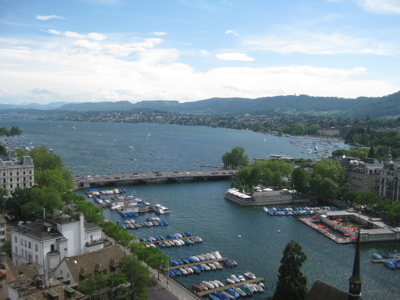Sunday, June 20, 2010
Dolomites
Zurich and Liechtenstein
Zurich, Switzerland. Doesn't really conjure up much passion, does it? So, why did Mom, Dad and I visit this "time is money" city? The Zurich Airport. Turns out back in 1983 when the former Swiss Air (now out of bankruptcy as Swiss International) purchased a 747 from Boeing and my Dad spent three months here as their technical adviser. He wanted to see the place again, and lo and behold, its not the same. There are more buildings and even the hotel he stayed at had built a new building and moved across the highway. After visiting the airport in Kloten, we headed downtown to walk around.
Just like Luzern, Zurich is situated at the northern tip of a lake (Lake Zurich) with a river flowing out of it (Limmat).
The Grossmunster. It was here in 1520 Huldrych Zwingli initiated the Swiss-German Reformation.
From one of the spires of the Grossmunster, looking across the Limmat River at the Fraumunster. Three of the five windows designed by Marc Chagall are seen here.
St. Peter's church, which has the world's largest church clockface. Seems fitting that the Swiss would have that title.
In this building, the Dada Art Movement was started in early part of the 20th century.
Next stop, Liechtenstein. It's the 4th smallest country in the world. It exists because the Liechtenstein family wanted a seat in the government of the Holy Roman Empire, so it bought this land. It has remained independent ever since.
It contains 62 square miles with most people living in the flat land and foothills by the Rhine River. To the west is Switzerland. To the east is Austria.
The country is known for its stamps, but it's economy is driven by being a business haven. It has a low corporate tax rate and therefore the country has more registered businesses than actual citizens. Of the four smallest countries in the world, I've hit three, San Marino and Vatican City being the other two. The one left....Monaco.
Luzern and Interlaken
Subscribe to:
Comments (Atom)




































